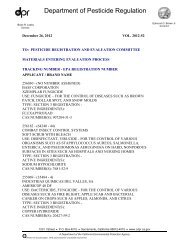Dichlorvos (DDVP) Risk Characterization Document - California ...
Dichlorvos (DDVP) Risk Characterization Document - California ...
Dichlorvos (DDVP) Risk Characterization Document - California ...
You also want an ePaper? Increase the reach of your titles
YUMPU automatically turns print PDFs into web optimized ePapers that Google loves.
I. SUMMARY<br />
A risk assessment has been conducted on dichlorvos (2,2-dichlorovinyl dimethyl phosphate, <strong>DDVP</strong>)<br />
because of possible adverse effects identified in rat and mouse oncogenicity, neurotoxicity, and<br />
genotoxicity studies. <strong>DDVP</strong> is listed under Proposition 65 as a chemical known to the State of<br />
<strong>California</strong> to cause cancer.<br />
INTRODUCTION<br />
Chemical Identification- <strong>DDVP</strong> is an organophosphate insecticide used for the control of pests in<br />
enclosed spaces such as buildings and residents, on pets, on vegetables in greenhouses, on<br />
commodities during post-harvest storage, and on livestock. From 1991 to 1993, approximately 4000-<br />
5000 pounds/year of <strong>DDVP</strong> were used primarily for structural and livestock pest control.<br />
<strong>DDVP</strong> exerts its toxicological activity primarily through the inhibition of acetylcholinesterase activity.<br />
Signs and symptoms associated with its toxicity included salivation, diarrhea, tremors, and death.<br />
Regulatory History- <strong>DDVP</strong> is currently under Special Review by the U.S. Environmental Protection<br />
Agency (USEPA). In 1989, the Scientific Advisory Panel of the USEPA recommended that <strong>DDVP</strong><br />
oncogenicity classification be changed from a B2 carcinogen to a C carcinogen. Because of<br />
oncogenic risks, most of the food tolerances have been revoked. A revocation of tolerances for<br />
bagged or packaged nonperishable commodities has been proposed. In 1993, the registrations of<br />
<strong>DDVP</strong> in <strong>California</strong> for the use on fresh vegetables were voluntarily cancelled by the registrants.<br />
Environmental Fate- <strong>DDVP</strong> is not likely to persist in the environment since it is volatile, does not bind<br />
to soil, and is hydrolyzed. The half-life of <strong>DDVP</strong> was 5.2 days in aqueous buffered solution at pH 7.<br />
The half-lives ranged from 9 to 20 days for <strong>DDVP</strong> in tap water with pH 7.5 to 8.1. <strong>DDVP</strong> was also<br />
degraded by soil microorganisms with a half-life of 10.2 hours. After foliar application, <strong>DDVP</strong> residues<br />
on the leaves may be volatilized, hydrolyzed, and absorbed into the plants.<br />
TOXICOLOGY PROFILE<br />
Pharmacokinetics- <strong>DDVP</strong> was rapidly absorbed by the oral, intravenous, intraperitoneal, and<br />
inhalation routes and slowly absorbed by the dermal route. After absorption, the radioactivity<br />
distributed to major organs including the liver and kidneys. <strong>DDVP</strong> was metabolized completely by<br />
ester hydrolysis and demethylation. Initial metabolites were mono- and dimethyl phosphates, and<br />
desmethyl <strong>DDVP</strong>. Once formed, they may be further metabolized. Final metabolites were either<br />
incorporated in tissues or excreted. Major routes of excretion were in the urine and in the exhaled air,<br />
while to a lesser extent in the feces and in the milk. Excretion routes, tissue distribution, and urinary<br />
metabolites in rats were similar following inhalation or oral exposures.<br />
Acute Toxicity- <strong>DDVP</strong> was more toxic than its metabolites as determined by the magnitude of the 72<br />
hour lethal dose after intraperitoneal administration. Human exposure of <strong>DDVP</strong> by ingestion and from<br />
the use of no-pest strips resulted in the inhibition of plasma cholinesterase (ChE) activity, but not<br />
erythrocyte ChE activity. Acute effects observed in laboratory animals from oral or inhalation<br />
exposures included diarrhea, irritability, salivation, lethargy, pupillary constriction, tremors, decreased<br />
neuromuscular functions, and death.<br />
Subchronic Toxicity- Subchronic exposures to <strong>DDVP</strong> resulted in the inhibition of brain, erythrocyte,<br />
or/and plasma ChE activities in humans, rats, mice, dogs, and cows. Clinical signs observed in<br />
laboratory animals were tremors, diarrhea, decreased body weight gain, increased frequency of<br />
salivation and urine staining in rats, and increased activity and urination in dogs. Other effects<br />
included statistically significant decreases in red blood cell parameters (cell counts, hemoglobin, and<br />
1
















